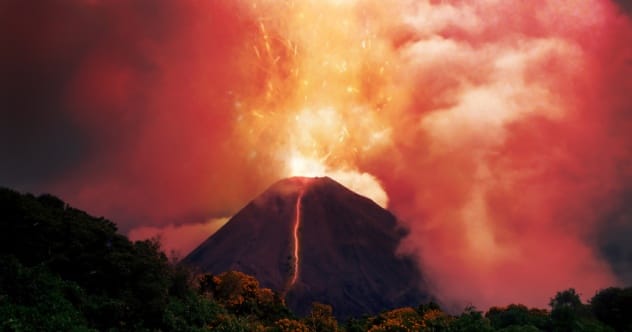Volcanoes are one of nature’s most spectacular and destructive forces. We all love watching them from a safe distance, especially when they threaten us. That fiery power is fascinating.
But how much do we really know about volcanic eruptions? It’s easy to get caught up in misconceptions. Let’s explore some common myths and uncover the amazing truths behind them!
1. Misconception: Molten Rock Powers Eruptions
Many believe that eruptions are powered by the sheer volume of molten rock beneath the surface. While magma is crucial, the real driver is gas.
Deep beneath our feet, magma forms under intense heat and pressure. This buoyant, red-hot liquid rock rises through cracks. As it ascends, gases like water vapor, carbon dioxide, and sulfur dioxide, dissolved within the magma, begin to bubble out due to decreasing pressure.
Think of opening a soda bottle: the released pressure allows carbon dioxide bubbles to appear. Similarly, these gases surge upwards, accelerating the magma and triggering a chain reaction that can lead to a powerful eruption. Without these gases, the magma might cool and solidify, never reaching the surface.
2. Misconception: Lava Always Erupts in Flows
We often picture lava flowing slowly down a volcano’s slopes. But lava can also explode onto the scene. The way lava erupts depends on several factors, including gas content, temperature, and viscosity.
Temperature is straightforward: hotter magma flows more easily. Viscosity, or resistance to flow, also plays a key role. Magma containing silica tends to be more viscous because silica molecules form long chains. Low-silica magma allows gases to escape, resulting in gentle lava flows.
High-viscosity, high-silica magma traps gases, building up immense pressure. When this pressure overcomes the surrounding rock, it results in explosive eruptions, scattering shattered lava across the landscape.
3. Misconception: Volcanoes Erupt Smoke
The impressive plumes rising from volcanoes aren’t smoke; they’re composed of rock and natural glass fragments, known as volcanic ash.
Unlike the fluffy ash from wildfires, volcanic ash consists of tiny, jagged particles of stone and glass. This ash can be heavy, with just four inches weighing 120–200 pounds per square yard. Accumulations can collapse roofs, damage electronics due to its conductivity, and harm machinery.
Volcanic Ash Advisory Centers (VAACs) worldwide constantly monitor ash clouds to ensure the safety of air travel, as volcanic ash can severely damage jet engines.
4. Misconception: Lava and Pyroclastic Flows Are the Deadliest Hazard
While pyroclastic flows are incredibly dangerous due to their speed and distance, lava flows are usually slow enough to avoid. However, mudflows, or lahars, are equally deadly.
Lahars form when water mixes with volcanic ash, creating a heavy, concrete-like mixture that races down river drainages. They can occur during or even without an eruption, requiring only water and loose ash.
Volcanic mudflows have caused nearly 60,000 deaths over the past five centuries, matching the fatality rate of pyroclastic flows. Getting caught in a lahar is as dangerous as being in a pyroclastic flow.
5. Misconception: Lakes Don’t Erupt
Although less known than volcanic eruptions at sea, lakes can indeed erupt. This phenomenon typically occurs when a volcano’s gases seep through the lake bed into the water.
Under specific conditions, these gases accumulate to a point where the lake explodes, releasing the stored gas in a deadly event. Lake Kivu, located near Mount Nyiragongo in the Democratic Republic of the Congo, is one such example.
Researchers fear that future volcanic activity under the city of Goma, on Lake Kivu’s shores, could trigger a lake eruption, leading to a catastrophic double tragedy.
6. Misconception: Eruptions Start at the Top of a Volcano
While many volcanoes have summit craters, eruptions can occur anywhere the rock is weak. Mount St. Helens famously exploded sideways in 1980 after a landslide exposed the magma inside the mountain.
In 1977 and 2002, Mount Nyiragongo’s lava lake drained through cracks in its rocky walls, causing flank eruptions lower down the slopes, resulting in many fatalities.
Volcanic fissures can form extensive networks, potentially hosting future eruptions. The possibility of eruptions occurring away from the summit is a constant concern in volcanically active regions.
7. Misconception: Exclusion Zones Are Suggestions, Not Rules
Exclusion zones around volcanoes exist for a reason: to save lives. Even experts can be caught off guard by sudden changes in volcanic activity.
In 1993, a team of volcanologists studying Colombia’s Galeras Volcano, which had been quiet for five months, were killed when it unexpectedly erupted. The volcano gave no warning, highlighting the unpredictable nature of these natural forces.
Exclusion zones are based on experience gained at the cost of numerous lives. They are not mere suggestions but essential rules for safety.
8. Misconception: All Big Eruptions Are Plinian
Not all explosive eruptions are Plinian. The Volcanic Explosivity Index (VEI) ranges from 0 (Hawaiian eruptions) to 8 (supereruptions), with several intermediate grades and four different Plinian types.
The eruption of Taal Volcano in January 2020 was a significant event but was classified as steam-related (“phreatomagmatic”), not Plinian. The VEI scale provides a common starting point for classifying eruptions, allowing geoscientists to differentiate between types and intensities.
For example, a VEI 4 eruption is classified as “Pelean/Plinian,” like Eyjafjallajokull in 2010, while a VEI 5 is “Plinian,” such as Mount St. Helens in 1980.
9. Misconception: Supereruptions Are Like Nuclear Blasts
Supereruptions, which eject at least 1,000 cubic kilometers of material, are often portrayed in films and games with nuclear-like effects. However, the reality is more complex.
While special effects artists often draw inspiration from nuclear blasts, very little is definitively known about supereruptions. Scientific explanations include “unzipping,” where multiple Plinian eruptions occur along ring fractures, and “boiling over,” where dense clouds of crystalline magma pour out.
Until we experience a supereruption firsthand, much of our understanding remains speculative.
10. Misconception: Any Supervolcano Eruption Means the End of the World
While a supereruption would have devastating global consequences, it doesn’t necessarily mean the end of the world. Small eruptions are more common, even at supervolcanoes like Yellowstone.
Yellowstone’s next eruption is most likely to be either a hydrothermal blast or a lava flow, both of which would have limited impact outside the park. Scientists monitoring Yellowstone could likely determine whether an impending eruption will be small or supersized based on precursors like seismicity and ground deformation.
Even a supereruption might not be an extinction-level event, although it would undoubtedly be a significant global crisis.
+1. Misconception: Supervolcanoes Are the Biggest Eruptions Known
Even bigger than supervolcanoes are large igneous provinces (LIPs), which occur on average every twenty million years. These events involve millions of cubic kilometers of molten rock flowing or exploding across the land for 1-5 million years.
The last such event occurred about 15 million years ago in the Pacific Northwest, forming the Columbia River Basalts. Although LIPs are massive, they occur over such extended periods that they don’t pose an immediate threat.
Researchers continue to find connections between ancient LIPs and modern volcanoes, such as the link between Yellowstone and the Columbia River Basalts LIP.
By understanding the realities behind these volcanic myths, we can better appreciate the awesome and sometimes terrifying power of volcanoes.
Leave your comments below and share your thoughts!










